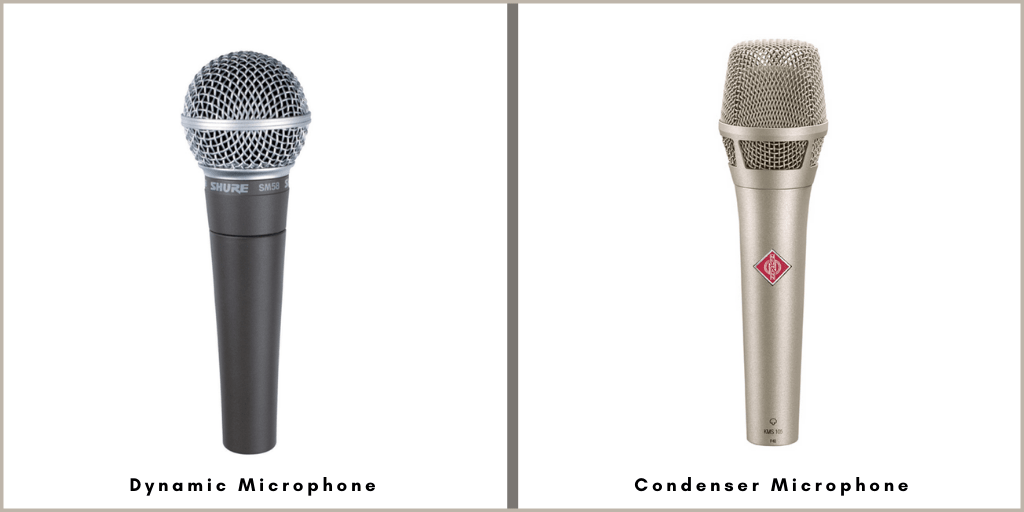For the first time microphone buyer, the choices can be daunting. Add to this the fact that everyone has their preference and opinion when using them, and getting sound, unbiased advice can become challenging. Luckily, we are here to help.
Below, we have prepared a quick, concise guide that will help you tell the difference between dynamic and condenser microphones. Let us help you with the tough decision by checking through the pros and cons.

What is a Dynamic Microphone?
A dynamic microphone is a very common type of microphone. It is the one you have most likely seen used with PA systems or in karaoke bars. This, however, does not mean it is a cheap and nasty choice.
Dynamic microphones are extremely versatile. They operate by allowing the sound to hit a small diaphragm in the head of the microphone. The diaphragm vibrates a coil that is wrapped around a magnet, producing a magnetic field that transfers the signal.
Most dynamic mics have a cardioid polar response pattern. This means that in general, they will only pick up sound sources placed in front of them, which is useful if you want to record or perform live but wish to minimize background noise.
Pros and Cons of a Dynamic Microphone
Dynamic microphones are generally very durable, making them good for every day, on the road use. They do not require an external power source (known as phantom power) such as batteries, though condenser mics do.
They are generally less expensive and, as mentioned above, are useful for minimizing background noise. This makes them a good live microphone, and they can be convenient in outdoor recordings.
The cons are that they will require an amplifier for output, and the choice of the amplifier can have a significant impact on the sound quality. They are also less sensitive than condensers, so if you want crisp vocals for ASMR style recordings, then they are probably not for you.
Finally, they can have a considerable variation in frequency response depending on the make and model.
What is a Condenser Microphone?
Condenser microphones are known as fragile and sensitive, though it does not always have to be the case. They pick up lots of nuances and sound from an environment, meaning they are ideal for some situations but too sensitive for others.
Condenser microphones run on the electrical principle of capacitance. Inside the head, they have two metal plates, one a movable diaphragm and the other a fixed metal backplate. When sound waves hit the diaphragm, it moves, changing the distance (capacitance) between the two plates.
The change in distance produces a change in the signal, and that is where the sound is produced. They can be very sensitive and can be omnidirectional (they pick up sound from all around). Because the plates inside have to be charged with electricity, they do require external power.
Pros and Cons of a Condenser Microphone
In general, condenser mics have a greater frequency range and sensitivity than a dynamic microphone. This means they will pick up clearer, more precise audio with greater volume depths. This is due to them being powered, which also results in stronger signals without the use of a preamp.
Downsides are that they require this “phantom power,” which makes them less appealing for use on the move. They are often more expensive and more fragile than dynamic microphones.
The biggest strength, its sensitivity, is also its biggest downfall. They can distort easy, and often you can find annoying background noises in your recording that you did not even know were there.
What is a Ribbon Microphone?
The final type of microphone that you may come across is a ribbon microphone. They work by suspending a thin piece of metal or film between a magnetic field, which moves when sounds hit it. This is transferred to a signal.
Ribbon mics are quite expensive these days and fairly old fashioned. They have a sound associated with rock and roll records and black and white TV, which can be niche. However, they are very delicate and expensive, making them generally unsuitable as a live microphone.
So Which Do I buy?
This all comes down to what your goals are and the environment in which you will be performing or recording.
If you are looking to record instruments such as guitar and want crisp sounds without background interference, then choose a dynamic. This is also true of people who want to record vocals (singing) at home. If you are taking equipment on the road, then a dynamic microphone is a great choice due to its durability.
If you want an environmental sound or recording, then pick a condenser. They are good for podcasts when multiple people are in one room, or to pick up the ambiance of a situation. They make conversational level talk clear and crisp.
Big Mistakes
One rookie mistake is to think that because condensers are more sensitive and more expensive, they are better for recording. That may be true in a studio, but in real life, you will just pick up the sounds of traffic and dogs outside your house.
When it comes to layering these recordings into tracks, it will get messy. The loud frequencies may also destroy that microphone you have just forked out all that cash on.
Getting the Environment Right
Once you have the microphone, the next step is to get your recording environment right. Do you need more help and advice choosing between dynamic and condenser microphones? We have lots of articles and guides on our blog to help you get your recording sounding professional.
Come and browse them today so you can sound like a virtuoso!